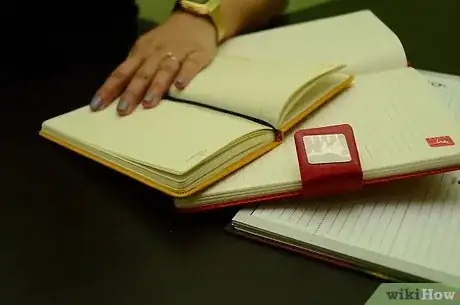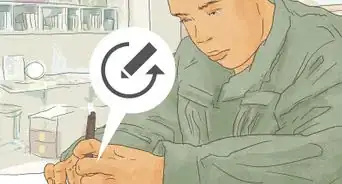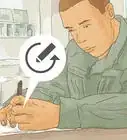X
wikiHow is a “wiki,” similar to Wikipedia, which means that many of our articles are co-written by multiple authors. To create this article, 17 people, some anonymous, worked to edit and improve it over time.
This article has been viewed 16,396 times.
Learn more...
All writers and readers realize the importance of writing strong descriptions of characters and settings. To a reader, a vivid description seems well-imagined and helps to picture either a person or a place. It may at first seem counter-intuitive, but what you expect to be a good description is all too often the opposite.
Steps
Method 1
Method 1 of 3:
Creating the Character
-
1Know your character well before you start trying to describe them. Write a few paragraphs about what the character does in the story:
- Where did they come from?
- Why are they there?
- What do they want?
- What will they do?
- How will they do it?
- and so on.
-
2Take notes on how you want the reader to feel about the character. Will the reader like them? Will the reader evoke them? and etc.
Advertisement
Method 2
Method 2 of 3:
Physical Characteristics
-
1Decide if the character has any defining physical characteristics. "Defining" is a term to be applied with discipline in writing fiction. If at a key moment in the story, the character has to reach up for an object on a high shelf, to give it to someone who could not reach it, then their height is a defining characteristic. If they are going to be mocked for their handlebar mustache, then their mustache is a defining characteristic. Although any physical attribute that does not feature in the plot or events of the story is not defined, and need not be defined, it will be more interesting. Try to use a thesaurus to think of better words (e.g.; large becomes huge or great). Though it will take you longer, you will be more prepared to write like a pro.
-
2Does the character have any symbolic physical characteristics? Symbolic physical characteristics are those which communicate to the reader (and to other characters) something about the personality of the character. If the character is gluttonous you might want to say that they have bulging jowls and multiple chins. If they are dynamic and active you might want to say that they are spry or athletic.
-
3If you want the character to have a particular physical trait, then try to come up with a reason for it that is either defining or symbolic. If you can't, then keep the detail to yourself.
-
4Avoid getting carried away with physical description. The character needs to be built up gently, therefore, and with a minimum of physical description, and the reader needs to be allowed to "get to know them" through the character's actions and words, rather than through what you tell the reader about the character -- in much the same way as you get to know a real person that you have just met.
- Readers do not usually "picture" a character when they are reading; they don't imagine all the visual details of the person. They get a vaguer, more general "feel" for what the character looks like. Even when the character has an important physical attribute like being very tall, or very blond, or wearing round spectacles, the reader often won't imagine the character like that.
- This is because the character's personality is much more important to the reader. The way the reader pictures the character arises more from the reader's memory than from the description given by the author. As the reader gets a feel for the personality of the character, they will start to picture him physically resembling a person or people that they know with a similar personality.
Advertisement
Method 3
Method 3 of 3:
Establishing the Character
-
1When you come to write your story, and you introduce the character, you will need to "establish" them. The establishment is giving the reader a firm and recognizable picture of the character, so that next time the character appears you will not have to remind the reader of who they are. You should always try to do this with as little detail as possible. Select a defining and or a symbolic physical characteristic. Select a couple of defining personality traits, and use only those.
-
2Try to refer to characteristics and traits obliquely or indirectly:
- instead of:
- John was tall and thin and wore his tee tucked tightly into his pants. He was always fastidiously neat.
- try something like:
-
John's tight blue tee was stretched down his long, lean torso, and tucked fastidiously into his freshly pressed pants, whose knife-edge creases sharpened his long, thin legs down to his sensible Oxfords
- A good trick is to avoid "was" or "is", for clothing to avoid "wear" and "wore", for eating to avoid “Eat” or “Ate”, etc.
-
3Say what the character is doing when you introduce them, and use that as a way to tell the reader about their personality:
- instead of:
- John was the anxious sort; he was always worried about trivial things."
- try something like:
- John stood on tiptoes, just back from the curb, trying to hail a cab with one hand and keep his umbrella over him with the other, all the time watching for the next car that might pass to close and splash dirt over his clean Chinos.
-
4Once you've got your character established, you can add more details about them at your leisure. You don't have to tell the reader everything right away. Just like getting to know a real person, let the reader find out more over time.
-
5Give your characters room to develop. This means that their personality can evolve and change in response to what happens in the story. This can affect their physical appearance (in which case the change may be both defining and symbolic). Think of how the events in the story might affect the character. Perhaps by the end, John will be less obsessed with the neatness of his clothes.
Advertisement
Warnings
- Avoid exhaustive detailed physical descriptions. Not only do they take time, but the reader has to put a lot of effort into working out what you mean. Stick to a few small details that suggest a fuller picture.⧼thumbs_response⧽
- The worst thing you can do is say that a character is an ideal physical beauty AND then describe their physical appearance in minute detail. Your idea of perfection may be very different from your reader's. Establish that the character is physically attractive through generalizations like good skin and hair, athletic or healthy physique, and physical symmetry, and let the reader imagine his or her ideal.⧼thumbs_response⧽
- Don't ever tell your reader that a character is handsome or beautiful. Ideally, you should get the reader to think about it without saying it. You can just about get away with statements like "everyone thought she was gorgeous" or "women kept saying how handsome he was".⧼thumbs_response⧽
- Don't tell the reader that a character is charming, attractive, or charismatic, either. These are all things that the reader will expect to be able to decide for themselves. And remember, your reader might dislike a character that you like. People don't all like the same kinds of people.⧼thumbs_response⧽
Advertisement
About This Article
Advertisement





































































